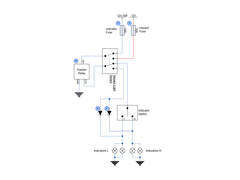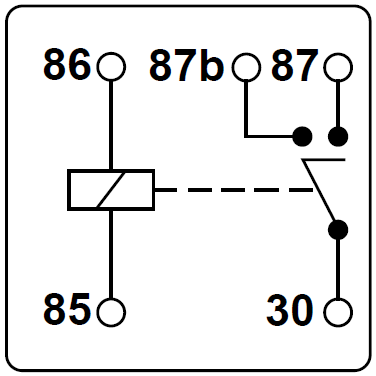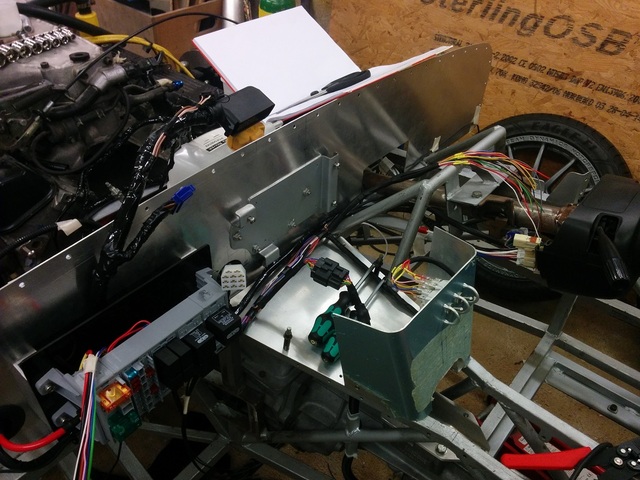
Single output relay to double output using diode
JekRankin - 14/5/18 at 08:35 PM
I've redone my car's electrics using 280 micro relays and fuses. Really pleased with how it has turned out.
However....I forgot to order a double output relay for my hazard circuit, and it seems no such thing exists in a 280 micro size.
My fusebox is full, so I can't easily add another relay single output relay. Instead, can I simply convert my single output relay to a double
output one using a diode? e.g connect the power feeds to both indicator circuits to the single output relay, but use a diode on one of the feeds to
isolate them from each other when the hazard relay is not energised?
Hope that question made sense..
02GF74 - 14/5/18 at 09:48 PM
What do you mean by single and double output.
Relays are denoted by poles and throws.
As stolen from Wikipedia.
SPST-NO (Single-Pole Single-Throw, Normally-Open) relays have a single Form A contact or make contact. These have two terminals which can be connected
or disconnected. Including two for the coil, such a relay has four terminals in total.
SPST-NC (Single-Pole Single-Throw, Normally-Closed) relays have a single Form B or break contact. As with an SPST-NO relay, such a relay has four
terminals in total.
SPDT (Single-Pole Double-Throw) relays have a single set of Form C, break before make or transfer contacts. That is, a common terminal connects to
either of two others, never connecting to both at the same time. Including two for the coil, such a relay has a total of five terminals.
DPST – Double-Pole Single-Throw relays are equivalent to a pair of SPST switches or relays actuated by a single coil. Including two for the coil, such
a relay has a total of six terminals. The poles may be Form A or Form B (or one of each; the designations NO and NC should be used to resolve the
ambiguity).
DPDT – Double-Pole Double-Throw relays have two sets of Form C contacts. These are equivalent to two SPDT switches or relays actuated by a single
coil. Such a relay has eight terminals, including the coil
The S (single) or D (double) designator for the pole count may be replaced with a number, indicating multiple contacts connected to a single actuator.
For example, 4PDT indicates a four-pole double-throw relay that has 12 switching terminals.
Also can you draw a circuit diagram to show what you want to achieve, far less ambiguous than the description, at least for me.
[Edited on 14/5/18 by 02GF74]
paulc - 14/5/18 at 11:58 PM
Hi,
This is what i'm going to do with my hazards / indicators.


Description
One caution, haven't actually tested it yet (Porbably a couple more weeks before that'll happen)
But I'm reasonably certain it'll work.
(12V_SW is the switched feed from the ignition switch)
The switching of the feed to the flasher relay is so the Hazards work with the ignition off (IVA requirement)
but the indicators only work when the ignition is on.
Paul
ken555 - 15/5/18 at 08:22 AM
That should work.
I have a similar set up but with a couple more diodes to power a single dash light

JekRankin - 15/5/18 at 09:18 AM
Yeah, sorry it would have been clearer with a diagram. I'll get one up later today when I get a spare min.
Instead of 'double output relay', I should have said 'Relay with dual contacts' - this is a single throw relay, but the armature
contacts two output pins at once. This allows you to send power to both the left hand and right hand indicator circuits at the same time, but when the
relay is switched off, the left and right hand indicator circuits are isolated from each other. See pic below:

From the two diagrams posted, it looks like I can achieve a similar logic using diodes...but I'll get a sketch of my circuit up to check.
Cheers,
Jek
[Edited on 15/5/18 by JekRankin]
craigdiver - 15/5/18 at 12:34 PM
quote:
Originally posted by JekRankin
I've redone my car's electrics using 280 micro relays and fuses. Really pleased with how it has turned out.
However....I forgot to order a double output relay for my hazard circuit, and it seems no such thing exists in a 280 micro size.
My fusebox is full, so I can't easily add another relay single output relay. Instead, can I simply convert my single output relay to a double
output one using a diode? e.g connect the power feeds to both indicator circuits to the single output relay, but use a diode on one of the feeds to
isolate them from each other when the hazard relay is not energised?
Hope that question made sense..
Couple of diodes will be fine, this is how the old moss alarms managed to flash all indicators without effecting normal indicator operation.
gremlin1234 - 15/5/18 at 05:44 PM
if you are using standard bulbs, then the diodes will need to be rated at 4A each
I would use a bridge rectifier, (as per ken555's design above) since its one package, and gives the wire for a panel light.
and go for an 8A,
http://uk.farnell.com/c/semiconductors-discretes/diodes/bridge-rectifier-diodes?forward-current-if-av-=8a
if using led then 1A diodes/rectifier will be fine.
Angel Acevedo - 21/10/18 at 10:25 AM
quote:
Originally posted by paulc
Hi,
This is what i'm going to do with my hazards / indicators.


Description
One caution, haven't actually tested it yet (Porbably a couple more weeks before that'll happen)
But I'm reasonably certain it'll work.
(12V_SW is the switched feed from the ignition switch)
The switching of the feed to the flasher relay is so the Hazards work with the ignition off (IVA requirement)
but the indicators only work when the ignition is on.
Paul
Hi Paul.
Did you get to install this?
Do you have pics of the install?
Would you be so kind to post?
I have a Daewoo Matiz Stering colum with switchgear -Except hazards and a Summit Racing harness.
I still haven´t figured out how I am going to match both with an Acewell providing the tell tales, although I may use a lighted Hazard switch (not
bought yet) for hazards.
Thanks for posting your diagram.
Regards
AA
paulc - 21/10/18 at 05:48 PM
Hi,
Yes, my wiring is all built and tested now.
I'm having difficulty uploading photographs at the moment, I'll post something up as soon as I figure out what I'm doing wrong.
I have a Mazda MX5 Column and switch gear. I've used seperate dials, warning lamps etc.
I've used seperate Left and Right tell tales, so they are wired in parallel with the indicator lamps.
My interpretation of the IVA manual is that I dont need a seperate hazard tell tale as the Left and Right flashing together is sufficient.
If you only have a single tell tale you can use two more diodes to connect that.
More to follow when i can upload a picture.
Paul
Angel Acevedo - 22/10/18 at 04:34 AM
quote:
Originally posted by paulc
Hi,
Yes, my wiring is all built and tested now.
I'm having difficulty uploading photographs at the moment, I'll post something up as soon as I figure out what I'm doing wrong.
Paul
In forum users best interest I can send you my e-mail and post pics for you..
Thanks for your help.
AA
paulc - 18/11/18 at 08:09 PM
Hi,
Apollogies for the slow reply. (been a little busy)
Looking through my pictures revelaed i didn't take very many of the wiring.
(Since then i've stripped the car back to a bare chassis an had it powder coated. the wiring loom is currently in a box under the dining room
table.)
Here's the picture i found:


Description
I used a modular fuse/relay panel, made up the wiring loom myself.
The flasher unit is in the Fuse/Relay panel (took some looking to find one short enough that the lid still fits)
The hazard switch is one of the toggle switches on the center console.
For the indicator switch i'm using the mazda column stalk. (MX5 Mk2 column)
After alot of dithering I put the diodes inline in the loom. They're in the straight section running back from the center console to the
firewall.
I did find diodes that fit in a blade fuse socket (so I could of put them in the fuse box) but they were really expensive, and it added alot of extra
wires in the loom. I am still a little worried as if they ever need changing it'll be a swine of a job. A lot of adhesive heat shink was used to
wrap them into the loom.
I have wiring diagrams for most of what i did. I need to tidy them up a bit but I could post them up if anyones interested.
Paul
[Edited on 18/11/18 by paulc]
Angel Acevedo - 19/11/18 at 12:36 PM
quote:
Originally posted by paulc
Hi,
Apollogies for the slow reply. (been a little busy)
Looking through my pictures revelaed i didn't take very many of the wiring.
(Since then i've stripped the car back to a bare chassis an had it powder coated. the wiring loom is currently in a box under the dining room
table.)
Here's the picture i found:


Description
I used a modular fuse/relay panel, made up the wiring loom myself.
The flasher unit is in the Fuse/Relay panel (took some looking to find one short enough that the lid still fits)
The hazard switch is one of the toggle switches on the center console.
For the indicator switch i'm using the mazda column stalk. (MX5 Mk2 column)
After alot of dithering I put the diodes inline in the loom. They're in the straight section running back from the center console to the
firewall.
I did find diodes that fit in a blade fuse socket (so I could of put them in the fuse box) but they were really expensive, and it added alot of extra
wires in the loom. I am still a little worried as if they ever need changing it'll be a swine of a job. A lot of adhesive heat shink was used to
wrap them into the loom.
I have wiring diagrams for most of what i did. I need to tidy them up a bit but I could post them up if anyones interested.
Paul
[Edited on 18/11/18 by paulc]
Thanks for posting.
I may as well go the diodes route as I cant find a Hazards switch that I like and has the arrangement shown on your first picture on the thread.
The Matiz column doesn´t have a hazards switch.
Best regards.
AA






